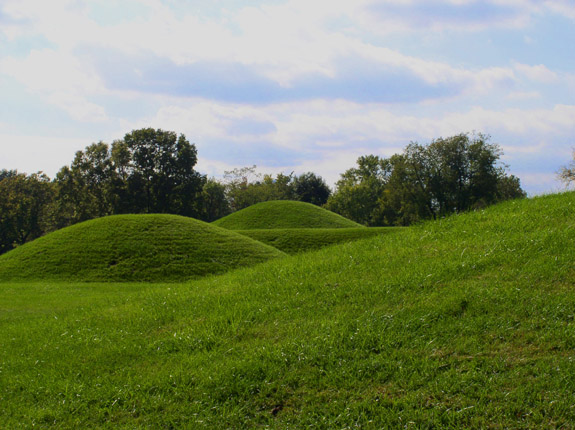|
Renner Village Archeological Site
The Renner Village Archeological Site (23PL1) is a prehistoric archaeological site located in the municipality of Riverside, Platte County, Missouri. It was a village site inhabited from approximately 1 CE to 500 CE by peoples of the Kansas City Hopewell culture and through the Woodland period to 1200 CE by peoples of the Middle Mississippian culture. It was added to the National Historic Register on April 16, 1969. Excavations Archaeologists have found artifacts relating to the Hopewell and Middle Mississippian at the site, which is one of several Kansas City Hopewell sites located near the junction of Line Creek and the Missouri River. The site was first excavated by Waldo Wedel of the US National Museum in 1937. He discovered decorated pottery styles typical of Hopewell pottery Hopewell pottery is the ceramic tradition of the various local cultures involved in the Hopewell tradition (ca. 200 BCE to 400 CE) and are found as artifacts in archeological sites in the America ... [...More Info...] [...Related Items...] OR: [Wikipedia] [Google] [Baidu] |
Platte County, Missouri
Platte County is a county located in the northwestern portion of the U.S. state of Missouri and is part of the Kansas City metropolitan area. As of the 2020 census, the population was 106,718. Its county seat is Platte City. The county was organized December 31, 1838, from the Platte Purchase, named for the Platte River. (''Platte'' is derived from the French word for a low, shallow, or intermittent stream.) The Kansas City International Airport is located in the county, approximately one mile west of Interstate 29 between mile markers 12 and 15. The land for the airport was originally in an unincorporated portion of Platte County before being annexed by Platte City, and eventually Kansas City. Geography According to the U.S. Census Bureau, the county has a total area of , of which is land and (1.5%) is water. The county's southwestern border with Kansas is formed by the Missouri River. Adjacent counties * Buchanan County (north) *Clinton County (northeast) *Clay County ... [...More Info...] [...Related Items...] OR: [Wikipedia] [Google] [Baidu] |
Kansas City Hopewell
The Kansas City Hopewell were the farthest west regional variation of the Hopewell tradition of the Middle Woodland period (100 BCE – 700 CE). Sites were located in Kansas and Missouri around the mouth of the Kansas River where it enters the Missouri River. There are 30 recorded Kansas City Hopewell sites. The sites are made up of distinctive pottery styles and impressive burial mounds containing stone vault tombs. It is however uncertain whether this culture developed locally when people adopted Hopewell traits, or if westward migrating Hopewell people brought it all with them. Hopewell Interaction Sphere The Hopewell Exchange system began in the Ohio and Illinois river valleys about 300 BCE. The culture is referred to more as a system of interaction among a variety of societies than as a single society or culture. Hopewell trading networks were quite extensive, as has been found by the evidence of goods such as obsidian from the Yellowstone area, copper from Lake Superior, a ... [...More Info...] [...Related Items...] OR: [Wikipedia] [Google] [Baidu] |
Mississippian Culture
The Mississippian culture was a Native Americans in the United States, Native American civilization that flourished in what is now the Midwestern United States, Midwestern, Eastern United States, Eastern, and Southeastern United States from approximately 800 CE to 1600 CE, varying regionally. It was known for building large, earthen platform mounds, and often other shaped mounds as well. It was composed of a series of urban settlements and satellite villages linked together by loose trading networks. The largest city was Cahokia, believed to be a major religious center located in what is present-day southern Illinois. The Mississippian way of life began to develop in the Mississippi River Valley (for which it is named). Cultures in the tributary Tennessee River Valley may have also begun to develop Mississippian characteristics at this point. Almost all dated Mississippian sites predate 1539–1540 (when Hernando de Soto explored the area), with notable exceptions being Natchez p ... [...More Info...] [...Related Items...] OR: [Wikipedia] [Google] [Baidu] |
Archaeological Site
An archaeological site is a place (or group of physical sites) in which evidence of past activity is preserved (either prehistoric or historic or contemporary), and which has been, or may be, investigated using the discipline of archaeology and represents a part of the archaeological record. Sites may range from those with few or no remains visible above ground, to buildings and other structures still in use. Beyond this, the definition and geographical extent of a "site" can vary widely, depending on the period studied and the theoretical approach of the archaeologist. Geographical extent It is almost invariably difficult to delimit a site. It is sometimes taken to indicate a settlement of some sort although the archaeologist must also define the limits of human activity around the settlement. Any episode of deposition such as a hoard or burial can form a site as well. Development-led archaeology undertaken as cultural resources management has the disadvantage (or the ben ... [...More Info...] [...Related Items...] OR: [Wikipedia] [Google] [Baidu] |
Riverside, Missouri
Riverside is a city in Platte County, Missouri and is part of the Kansas City metropolitan area within the United States. The population was 2,937 at the 2010 census. History Riverside lies on the edge of the Missouri River and was formally incorporated in 1951. For many years, the town was known for its Riverside Race Track. The Riverside Park Jockey Club operated from 1928 to 1937 and was popularly called “Pendergast Track” after its patron, big city boss Tom Pendergast (although Pendergast was not officially on its organization papers). The horse racing track was on the site of a former dog racing track. The track operated under a questionable legal basis. The site was supplanted by an automobile race track, which closed in the 1990s. A legal gambling establishment on the river now is the $106 million casino run by Argosy Gaming Company. One of the landmarks in Riverside is the Riverside Red X store. It was founded as a gas station in 1948 by Edward Young. Over time, ... [...More Info...] [...Related Items...] OR: [Wikipedia] [Google] [Baidu] |
Woodland Period
In the classification of :category:Archaeological cultures of North America, archaeological cultures of North America, the Woodland period of North American pre-Columbian cultures spanned a period from roughly 1000 Common Era, BCE to European contact in the eastern part of North America, with some archaeologists distinguishing the Mississippian period, from 1000 CE to European contact as a separate period. The term "Woodland Period" was introduced in the 1930s as a generic term for prehistoric, prehistoric sites falling between the Archaic period in the Americas, Archaic hunter-gatherers and the agriculturalist Mississippian cultures. The Eastern Woodlands cultural region covers what is now eastern Canada south of the Subarctic region, the Eastern United States, along to the Gulf of Mexico. This period is variously considered a developmental stage, a time period, a suite of technological adaptations or "traits", and a "family tree" of cultures related to earlier Archaic cultures. ... [...More Info...] [...Related Items...] OR: [Wikipedia] [Google] [Baidu] |
Middle Mississippian Culture
The Mississippian culture was a Native American civilization that flourished in what is now the Midwestern, Eastern, and Southeastern United States from approximately 800 CE to 1600 CE, varying regionally. It was known for building large, earthen platform mounds, and often other shaped mounds as well. It was composed of a series of urban settlements and satellite villages linked together by loose trading networks. The largest city was Cahokia, believed to be a major religious center located in what is present-day southern Illinois. The Mississippian way of life began to develop in the Mississippi River Valley (for which it is named). Cultures in the tributary Tennessee River Valley may have also begun to develop Mississippian characteristics at this point. Almost all dated Mississippian sites predate 1539–1540 (when Hernando de Soto explored the area), with notable exceptions being Natchez communities. These maintained Mississippian cultural practices into the 18th century. C ... [...More Info...] [...Related Items...] OR: [Wikipedia] [Google] [Baidu] |
National Historic Register
The National Register of Historic Places (NRHP) is the United States federal government's official list of districts, sites, buildings, structures and objects deemed worthy of preservation for their historical significance or "great artistic value". A property listed in the National Register, or located within a National Register Historic District, may qualify for tax incentives derived from the total value of expenses incurred in preserving the property. The passage of the National Historic Preservation Act (NHPA) in 1966 established the National Register and the process for adding properties to it. Of the more than one and a half million properties on the National Register, 95,000 are listed individually. The remainder are contributing resources within historic districts. For most of its history, the National Register has been administered by the National Park Service (NPS), an agency within the U.S. Department of the Interior. Its goals are to help property owners and inter ... [...More Info...] [...Related Items...] OR: [Wikipedia] [Google] [Baidu] |
Hopewell Tradition
The Hopewell tradition, also called the Hopewell culture and Hopewellian exchange, describes a network of precontact Native American cultures that flourished in settlements along rivers in the northeastern and midwestern Eastern Woodlands from 100 BCE to 500 CE, in the Middle Woodland period. The Hopewell tradition was not a single culture or society but a widely dispersed set of populations connected by a common network of trade routes. At its greatest extent, the Hopewell exchange system ran from the northern shores of Lake Ontario south to the Crystal River Indian Mounds in modern-day Florida. Within this area, societies exchanged goods and ideas, with the highest amount of activity along waterways, which were the main transportation routes. Peoples within the Hopewell exchange system received materials from all over the territory of what now comprises the mainland United States. Most of the items traded were exotic materials; they were delivered to peoples living in the majo ... [...More Info...] [...Related Items...] OR: [Wikipedia] [Google] [Baidu] |
Line Creek (Missouri)
Line Creek is a stream in Platte County in the U.S. state of Missouri Missouri is a U.S. state, state in the Midwestern United States, Midwestern region of the United States. Ranking List of U.S. states and territories by area, 21st in land area, it is bordered by eight states (tied for the most with Tennessee .... It is a tributary of the Missouri River. Line Creek was named for the fact its course flows parallel to the Clay—Platte county line. References Rivers of Platte County, Missouri Rivers of Missouri {{PlatteCountyMO-geo-stub ... [...More Info...] [...Related Items...] OR: [Wikipedia] [Google] [Baidu] |
Hopewell Pottery
Hopewell pottery is the ceramic tradition of the various local cultures involved in the Hopewell tradition (ca. 200 BCE to 400 CE) and are found as artifacts in archeological sites in the American Midwest and Southeast. The Hopewell were located around the Mississippi and Illinois Rivers during the Middle Woodland Period, and the Hopewell Interaction Sphere spanned from the Gulf of Mexico to Ontario, Canada. Uses This pottery was used in a variety of ways: from storage and cooking to holding offerings during burial ceremonies. Ceremonial pottery was noticeably more delicate and elaborate than pottery for domestic use.Seeman, 65 Techniques Although there are many techniques and methods of pottery production, the method most likely used in the Hopewell culture was the coiled method. After making the initial form of the vessel a paddle and anvil would then be used to further shape and smooth the pot. The final two steps are decoration and firing. Before firing, Hopewell pottery wa ... [...More Info...] [...Related Items...] OR: [Wikipedia] [Google] [Baidu] |







